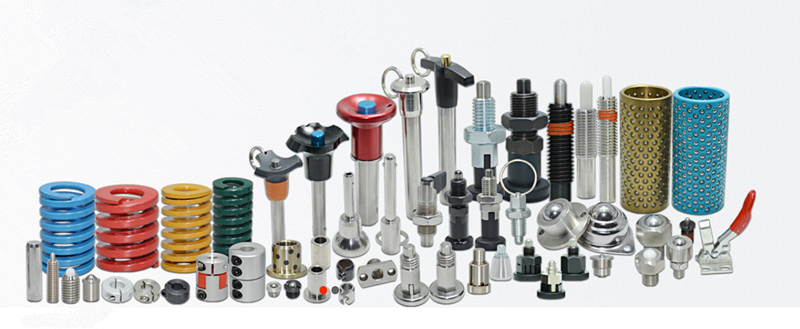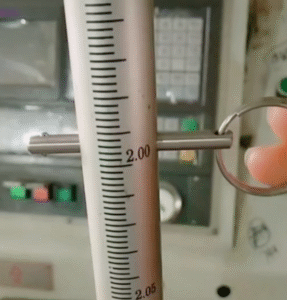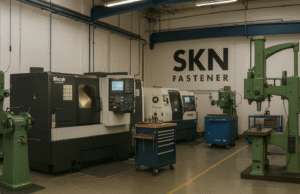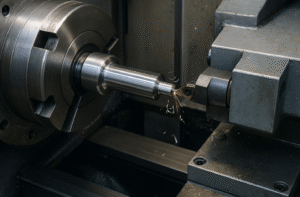Pino de liberação rápida
Quando se trata de soluções de fixação que combinam velocidade, resistência e confiabilidade, poucos componentes são tão eficazes quanto o pino de liberação rápida. Seja na montagem de maquinário pesado, no projeto de sistemas aeroespaciais ou na busca de uma maneira confiável de fixar equipamentos modulares, os pinos de liberação rápida oferecem uma solução prática e de alto desempenho. Mas o que são eles exatamente e como escolher o pino certo para a sua aplicação?
Este guia foi elaborado para compradores industriais, engenheiros e profissionais de compras que precisam de um entendimento claro e prático dos pinos de liberação rápida e de suas diversas aplicações.
O que é um pino de liberação rápida?
Um pino de liberação rápida é um fixador mecânico projetado para conexão e desconexão rápida e repetida de duas ou mais peças - sem a necessidade de ferramentas. Diferentemente dos parafusos padrão, os pinos de liberação rápida permitem que os usuários travem ou destravem manualmente uma junta com um simples movimento de empurrar, puxar ou girar.
A maioria dos pinos de liberação rápida incorpora um mecanismo de travamento acionado por mola, como um botão, uma esfera ou um detentor, que mantém o pino no lugar com segurança até que seja deliberadamente liberado. Isso os torna ideais para aplicações que exigem montagem, desmontagem ou ajuste frequentes.
Estrutura básica de um pino de liberação rápida
Embora o design específico possa variar de acordo com o tipo de pino, a maioria dos pinos de liberação rápida compartilha alguns componentes principais:
- Corpo do pino: O eixo cilíndrico que se encaixa através de orifícios alinhados nos componentes conectados.
- Punho ou alça: A interface do usuário para inserir ou remover o pino. Os tipos comuns incluem alças em T, alças de anel e botões de pressão.
- Mecanismo de travamento: Um sistema acionado por mola - normalmente usando esferas ou um êmbolo retrátil - que engata quando o pino é inserido.
- Botão de liberação ou anel de tração: Permite que o usuário desengate o mecanismo de travamento e remova o pino rapidamente.
Tipos comuns de pinos de liberação rápida
Há vários tipos de pinos de liberação rápida disponíveis, cada um deles adequado a diferentes aplicações e requisitos operacionais.
1. Pinos de trava esférica
Os pinos de trava esférica, também conhecidos como pinos de retenção, são um dos tipos mais usados. Eles apresentam pequenas esferas de travamento perto da extremidade do pino, que são empurradas para fora por uma mola interna quando o pino é inserido em um orifício. Pressionar um botão ou puxar um anel retrai as esferas, permitindo que o pino seja removido facilmente.
Aplicações típicas: Maquinário industrial, ferramentas aeroespaciais, sistemas de automação.
2. Pinos de liberação rápida da alça em T
Os pinos com alça em T oferecem uma aderência robusta, facilitando a operação mesmo com luvas ou em espaços apertados. Eles são usados com frequência em ambientes de trabalho pesado, onde os usuários precisam de um puxão sólido para remover o pino.
Aplicações típicas: Equipamentos de solo para aeronaves, maquinário de construção, gabaritos e acessórios.
3. Pinos do botão de pressão
Esses pinos apresentam um botão de pressão embutido na cabeça, o que permite uma instalação de baixo perfil. Pressionar o botão retrai os elementos de travamento, permitindo a remoção.
Aplicações típicas: Equipamentos médicos, dispositivos de transporte, montagens compactas.
4. Pinos da alça em L e da alça em anel
Essas variantes oferecem estilos alternativos de empunhadura, dependendo do espaço de instalação e da preferência do usuário. As alças de anel são usadas com frequência quando os pinos são fixados por meio de cordões.
Aplicações típicas: Hardware marítimo, sistemas de defesa, móveis modulares.
Principais benefícios dos pinos de liberação rápida
Os pinos de liberação rápida oferecem várias vantagens em relação aos fixadores convencionais:
- Operação sem ferramentas: Ideal para ambientes onde a velocidade e a conveniência são essenciais.
- Alta resistência ao cisalhamento: Projetado para suportar cargas pesadas e, ao mesmo tempo, manter a facilidade de uso.
- Reutilização: Projetado para uso repetido sem desgaste dos componentes de encaixe.
- Compacto e leve: Particularmente importante nos setores aeroespacial e de transportes.
- Versátil: Pode ser usado em uma ampla gama de aplicações e setores.
Opções de materiais e acabamentos de superfície
A seleção do material correto é fundamental para o desempenho e a longevidade. Os materiais comuns incluem:
- Aço inoxidável (304/316): Resistente à corrosão, adequado para ambientes marinhos ou médicos.
- Aço carbono (zincado ou óxido preto): Econômico, forte, mas menos resistente à corrosão.
- Alumínio: Leve e resistente à corrosão, geralmente usado no setor aeroespacial.
- Titânio: Alta relação resistência/peso e excelente resistência à corrosão - ideal para setores de alto desempenho.
Dependendo da aplicação, os pinos também podem ser fornecidos com revestimentos, como
- Revestimento de zinco
- Óxido preto
- Passivação
- Anodização (para alumínio)
Aplicações em todos os setores
Os pinos de liberação rápida são usados em uma ampla gama de setores em que é necessária uma fixação rápida e repetível:
| Setor | Exemplos de aplicativos |
|---|---|
| Aeroespacial | Interiores de aeronaves, equipamentos de apoio no solo |
| Automotivo | Esportes motorizados, sistemas de ajuste de assento |
| Marinha | Escadas dobráveis, corrimãos, sistemas de amarração |
| Médico | Carrinhos modulares, equipamentos cirúrgicos |
| Construção | Maquinário pesado, andaimes, ferramentas de troca rápida |
| Automação e robótica | Ferramentas de fim de braço, acessórios, sistemas de posicionamento |
| Militar e Defesa | Suportes de armas, sistemas de implantação rápida |
Como selecionar o pino de liberação rápida correto
A escolha do pino de liberação rápida correto depende de vários fatores:
1. Requisitos de carga de cisalhamento
Determine a carga máxima que o pino deve suportar em operação. Use os dados do fabricante para confirmar que a resistência ao cisalhamento do pino selecionado atende às necessidades de sua aplicação.
2. Compatibilidade de materiais
Combine o material do pino com seu ambiente. Para uso marítimo ou externo, o aço inoxidável é normalmente a melhor opção. Para aplicações sensíveis ao peso, considere o alumínio ou o titânio.
3. Tipo de alça
Dependendo da acessibilidade e das restrições de espaço, selecione um tipo de alça que permita fácil utilização: alça em T, alça em anel ou botão de pressão.
4. Diâmetro e comprimento
O tamanho exato do pino é essencial para o desempenho e a segurança. Certifique-se de que ele corresponda exatamente às dimensões do furo e ao espaçamento entre os componentes.
5. Recursos de retenção
Em ambientes de alta vibração, considere pinos com mecanismos de travamento secundário ou clipes de segurança para evitar o desengate acidental.
Padrões e especificações comuns
Dependendo do seu setor, você pode precisar de pinos que atendam a determinados padrões:
- MIL-SPEC (Padrões militares dos EUA)
- DIN / ISO (Padrões industriais europeus)
- ASME / ANSI (Padrões de engenharia mecânica dos EUA)
Verifique com seu fornecedor se os pinos atendem a esses requisitos, especialmente para aplicações aeroespaciais, médicas ou de defesa.
Considerações finais
Os pinos de liberação rápida são um componente pequeno, mas essencial, em muitos sistemas industriais. Sua capacidade de oferecer conveniência e desempenho faz com que sejam uma solução de fixação em uma ampla variedade de setores. Ao entender seu design, função e critérios de seleção, os compradores industriais podem tomar decisões informadas que aumentam a segurança, a eficiência e a confiabilidade de seus equipamentos.
Se estiver procurando um fabricante confiável de pinos de liberação rápida - incluindo pinos de trava esférica, pinos de botão de pressão e variantes de alça em T - a SKN Fasteners oferece soluções personalizadas criadas para atender aos padrões globais. Entre em contato conosco para solicitar uma cotação ou discutir sua aplicação específica.





